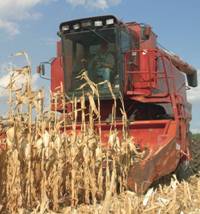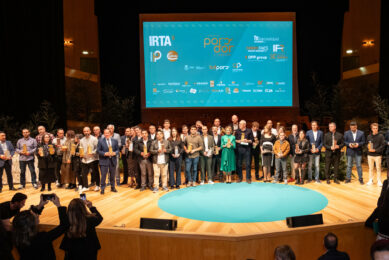Current thinking in piglet nutrition – ingredients

In the previous issue, a start was made with an update on ‘current thinking in piglet nutrition’. Dietary specifications were discussed there. This month, a follow up on piglet nutrition is published on both ingredients and feed manufacturing.
By Dr Ioannis Mavromichalis, Ariston Nutrition, Madrid, Spain
INGREDIENTS
Energy sources
Maize, wheat, and sorghum constitute the major energy sources of most nursery diets around the world. Barley and oats are also frequently used, whereas rye and triticale are not very popular because they are rich in antinutritional factors. Tapioca is also an excellent energy source and its use is guaranteed in areas where cereals are comparatively expensive. Rice, especially broken rice, is used mainly in Asia. Cereal by-products, such as those from the production of wheat flour or corn wet-milling are also used in diets for young pigs but not in diets immediately following weaning.
Oils are generally favoured over animal fats for young pigs because they are more digestible. Thus, oils extracted from soybeans, maize, and sunflower are most frequently used during the first two weeks post-weaning, whereas animal fats (where still permitted) such as lard and tallow are favoured in the later phases of the nursery period. Recently, fish oil has created considerable interest because of possible immuno-potentiating properties of enhanced n6:n3 fatty acid ratio, but research has yet to yield meaningful and conclusive answers.
Milk products are invariably used in nursery diets to provide lactose and highly digestible protein. Whey and skim milk are the main dairy products used throughout the world. Whey co-products and straight lactose are also effective in enhancing post-weaning growth, although they tend to be more expensive than dried whey.
Protein sources
Fishmeal is an excellent source of protein for young pigs, yet price and availability may limit its use. Recent regulations in European Union created further hurdles in fishmeal use, which resulted in its abandonment by some commercial feed manufacturers.
Other major animal-derived protein sources include dairy proteins (such as casein and whey protein concentrates), poultry by-products, meat and bone meal, and blood products (where permitted). Blood plasma protein is an established ingredient in nursery diets because it improves growth performance by as much as 50% during the first couple weeks post-weaning, although the magnitude of response depends on diet composition and animal health. Plant proteins frequently used in nursery diets include soybean meal, soybean protein products, wheat gluten, potato protein, peas, lupins, sunflower meal (decorticated), fava beans, and lentils, depending on price and local availability. Soybeans and most other plant protein sources are rich in antinutritional factors and thus, heat treatment is needed to make these ingredients suitable for young pigs. Plant proteins are frequently restricted in the first two weeks post-weaning to avoid inflammatory reactions to antigenic proteins that are usually found in these ingredients. But, past the initial post-weaning phase, plant protein sources supply the majority of amino acids in practical diets for young pigs.
Growth-promoting minerals
Copper sulphate and zinc oxide are well-established mineral salts that enhance growth performance and reduce symptoms of diarrhoea in post-weaned pigs. Up to 3,000 ppm zinc from zinc oxide are frequently added in diets during the first couple weeks post-weaning to enhance growth performance and reduce symptoms of diarrhoea. Also, up to 250 ppm copper from copper sulfate is recommended for the remainder nursery period. These mineral salts are not additive, but their action is additive to that of antimicrobial agents.
FEED MANUFACTURING
Grinding
The degree of grinding and fineness of ingredients in diets for young pigs has received considerable attention. It is generally accepted that a finer particle size increases the surface available for enzymatic digestion and also the fluidity of digesta resulting, thus, in better mixing. From a comprehensive literature review it has been suggested that 1.3% improvement in feed efficiency should be expected for each 100-micron reduction in particle size.
Recent attention to the particle size of soybean meal has yielded conflicting results. In a recent study, reducing particle size from 900 to 600 microns improved amino acid digestibility, but not that of energy, without further improvements as particle size was reduced to 150 microns.
Pellet quality
It is widely accepted today that pelleting improves growth rate and feed efficiency by about 10% in nursery pigs. Because the beneficial effects of pelleting are likely to decrease during the later phases of the nursery period, pelleting costs must be weighed against benefits in performance and perhaps, reduced nutrient excretion.
Pellet quality has been traditionally associated with durability, a desirable trait in pelleted diets for young pigs. A pellet durability index over 90% is used today as a target for the feed industry. An increased concentration of fine particles in feed not only increases the probability of feeder bridging, but it also increases feed wastage and thus, restricts growth performance (Table 1).
In a recent study, feed intake (-13%) and weight gain (-11%) were markedly reduced in pigs during the first couple of weeks post-weaning when they were offered hard versus soft pellets that contained over 30% fines (Figure 1), indicating that pellet durability index is not an adequate criterion of pellet quality for young pigs.
Another aspect of pellet quality is pellet size and more precisely pellet diameter. There is a well-established notion that small pigs require small pellets to thrive. Yet, research indicates that piglets as young as 14-21 days old can easily cope with any pellet size ranging from 1-12 mm, although wastage may be excessive in pellets larger than 3-4 mm (Table 2).
Mixing uniformity
Mixing uniformity, as estimated by coefficient of variation (CV) of a specific nutrient or ingredient (usually salt), is used to define appropriate dispersion of ingredients throughout a batch of feed.
It is recommended that a coefficient of variation less than 10% indicates appropriate mixing. In an earlier study, pigs offered diets mixed for 0.5 minutes had increased growth performance compared to pigs offered unmixed diets. Yet, performance was not improved with four minutes mixing time. In that study, coefficient of variability decreased from 107 to 28 to 12% as mixing time increased from 0 to 0.5 to 4 minutes, respectively.
Conclusions
The field of piglet nutrition remains a challenging subject. A quality diet post-weaning is essential in alleviating the shock and consequences of early weaning. Reducing diet cost by lowering quality only prolongs the symptoms of post-weaning growth depression with negative impact on overall growth performance and health. A progressive formula produced under good manufacturing conditions and coupled with expert feeding management is the key to feeding piglets under modern commercial facilities.
Source: Pig Progress Volume 25 nr 8











